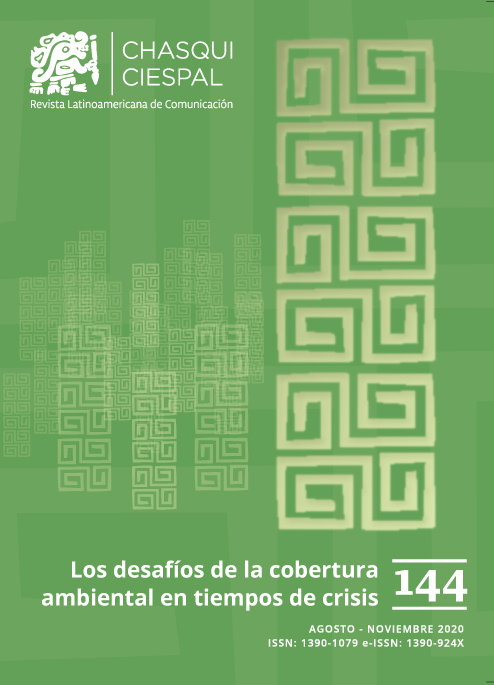Cobertura del cambio climático en los medios digitales de América Latina
DOI:
https://doi.org/10.16921/chasqui.v0i144.4286Palabras clave:
Cobertura mediática, cambio climático, medios de comunicación, cumbre del climaResumen
El estudio analizó el tratamiento informativo del cambio climático (CC) de los medios de comunicación de América Latina durante las cumbres mundiales de Lima, (2015), París (2015) Marruecos (2016) y Bonn (2017). Los resultados del análisis de contenido de 339 piezas informativas mostraron la prevalencia de los marcos políticos, seguido de relaciones internacionales. Las fuentes políticas, destacados en el papel de colaboradores, dominaron el debate sobre el clima. Las noticias tienden a reflejar un tono conformista y mencionar alguna solución. El estudio concluye que las historias tienen un enfoque internacional y no derivan a las necesidades locales de temas relacionados con la crisis climática.
Citas
Arcila, C., Mercado, M., Piñuel, J. L., & Suarez, E. (2015). Media coverage of climate change in spanish online media. Convergencia Revista de Ciencias Sociales (68), 72-95.
Arcila, C., Freyle , J., & Mecado, M. (2015). De la Cumbre de Nairobi (2006) a Copenhague (2009): cobertura del cambio climático en medios digitales en español. Cuadernos.Info (37), 107-119.
Barkemeyer, R., Figge, F., Hoepner, A., Holt, D., Kraak, J., & Yu, P. (2017). Media coverage of climate change: An international comparison. Environment and Planning C: Politics and Space , 35 (6), 109-1054.
Boykoff, J., & Boykoff, M. (2004). Balance as bias: global warming and the US prestige press. Global Environmental Change: Human and Policy Dimensions , 14 (2), 125-136.
Boykoff, M., & Robert, J. (2007). Media Coverage of Climate Change: Trends, Strenghs, Weaknesses. United Nations Development Programme - Human Development Report
Bryant, J., & Miron, D. (2004). Theory and research in mass communication. Journal of Communication, 54(4), 662–704.
Carvalho, A., & Burgess, J. (2005). Cultural Circuits of Climate Change in U.K. Broadsheet Newspapers, 1985–2003. Risk Analysis , 25 (6), 1457-1469.
Dotson, D., Jacobson, S., Kaid, L., & Stuart, J. (2012). Media Coverage of Climate Change in Chile: A Content Analysis of Conservative and Liberal Newspapers. Environmental Communication , 64 (1), 64-81.
El Espectador. (2014, noviembre 23). Listo el Fondo Verde para el Clima. Recuperado de https://www.elespectador.com/noticias/medio-ambiente/listo-el-fondo-verde-el-clima-articulo-529166
EFE. (2020, junio 1). Investigación advierte sobre acelerada extinción de animales vertebrados. El Heraldo. Recuperado de https://www.elheraldo.co/ciencia/investigacion-advierte-sobre-acelerada-extincion-de-animales-vertebrados-730822
El Tiempo. (2020, junio 1). El declive de la biodiversidad tropical marina será peor a fin de siglo. Recuperado de: https://www.eltiempo.com/vida/ciencia/el-declive-de-biodiversidad-tropical-marina-sera-peor-a-fin-de-siglo-501982#:~:text=Ciencia-,El%20declive%20de%20biodiversidad%20tropical%20marina%20ser%C3%A1%20peor%20a%20fin,tropical%20hasta%20niveles%20sin%20precedentes.
El Tiempo. (2020, junio 26). Pese a la pandemia, perdimos 75 mil hectáreas de bosque en Colombia. Recuperado de https://www.eltiempo.com/vida/medio-ambiente/pese-a-pandemia-perdimos-75-mil-hectareas-de-bosque-en-colombia-501340
Entman, R. (1993). Framing: Toward a clarification of a fractured paradigm. Journal of Communication , 43 (3), 51-58.
Gordon , J., Deines, T., & Havice, J. (2010). Global Warming Coverage in the Media: Trends in a Mexico City Newspaper. Science Communication , 32 (2), 143-170.
INFORM-LAC (2018). Índice de gestión de riesgos para América Latina y el Caribe. Unicef. Recuperado de https://www.unicef.org/lac/media/1601/file
IPCC. (2018). Global warming of 1.5. The Intergovernmental Panel on Climate Change. Obtenido de https://www.ipcc.ch/sr15/
Kleinschmit, D., & Sjostedt, V. (2014). Between science and politics: Swedish newspaper reporting on forests in a changing climate. Environmental Science & Policy , 35, 117-127.
Mercado, M. (2012). Media representations of climate change in the Argentinean press. Journalism Studies , 13 (2), 193-209.
Fountain, H. (2020, junio 2). Going in the Wrong Direction: More Tropical Forest Loss in 2019. The New York Times Recuperado de https://www.nytimes.com/2020/06/02/climate/deforestation-climate-change.html?action=click&module=News&pgtype=Homepage
Painter, J. (2010). Summoned by Science Reporting Climate Change at Copenhage and Beyond. Reuters Institute for the Study of Journalism. Recuperado de https://reutersinstitute.politics.ox.ac.uk/fileadmin/documents/Publications/Challenges/Summone d_by_Science.pdf
Pasquaré, F., & Oppizzi, P. (2012). How do the media affect public perception of climate change and geohazards? An Italian case study. Global and Planetary Change , 90-91, 152-157.
Pulver, S., & Sainz-Santamaría, J. (2018). Characterizing the climate issue context in Mexico: reporting on climate change in Mexican newspapers, 1996–2009. Climate and Development , 10 (6), 538-551.
Schäfer, M., Ivanova, A., & Schmidt, A. (2014). What drives media attention for climate change? Explaining issue attention in Australian, German and Indian print media from 1996 to 2010. International Communication Gazette , 76, 152-176.
Schäfer, M., & Schlichting, I. (2014). Media representations of Climate Change: A Meta-Analysis of the Research Field. Environmental Communication , 8 (2), 142-160.
Schäfer, M., Ivanova, A., & Schmidt, A. (2013). Media attention for climate change around the world: A comparative analysis of newspaper coverage in 27 countries. Global Environmental Change , 23, 1233-1245.
Zamith, R., Pinto, J., & Villar, M. (2013). Constructing climate change in the Americas: An analysis of news coverage in U.S. and South American newspapers. Science Communication , 35 (3), 334-357.
Publicado
Cómo citar
Número
Sección
Licencia
- Los autores/as conservarán plenos derechos de autor sobre su obra y garantizarán a la revista el derecho de primera publicación, el cuál estará simultáneamente sujeto a la Licencia Reconocimiento-SinObraDerivada de Creative Commons (CC BY-ND), que permite a terceros la redistribución, comercial y no comercial, siempre y cuando la obra no se modifique y se transmita en su totalidad, reconociendo su autoría.
- Los autores/as podrán adoptar otros acuerdos de licencia no exclusiva de distribución de la versión de la obra publicada (p. ej.: depositarla en un archivo telemático institucional o publicarla en un volumen monográfico) siempre que se indique la publicación inicial en esta revista.
- Se permite y recomienda a los autores/as difundir su obra a través de Internet.












